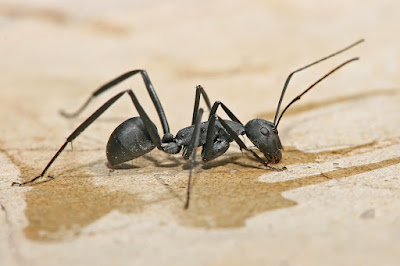Rare Nocturnal Northern Tamandua Anteater Caught Drinking Something Unusual
Northern Tamandua Anteaters are nocturnal arboreal dwellers. This means they run around in the treetops at night. The video embedded in this post shows rare footage of a Northern Tamandua Anteater doing something biologist Tracie Stice had never seen this type of anteater ever do before in her 20 years of living in the rainforest!!
What was the odd behaviour this biologist caught the anteater doing?
Check out the video below and see what this anteater was up to that night in the trees!
Note: Posts on this blog have referral links that can help our authors eat when you shop through them. Want to join in the writing fun? Pop a note in the comments below.
 |
| Stuffed Anteater- $27.95 Soft plush partially bean-filled plush anteater from Leosco with an informative hangtag. 17 Inches Long, Nose to Tail. |
Wildlife Videographer Captures Rare Nocturnal Anteater Footage!
The Northern Tamandua Anteater in the video below did something wildlife videographer, Tracie Stice, had never seen in all her twenty years of living in the rain forest. Watch this night footage very carefully and you will see this anteater open a coconut and drink the water inside it!
Northern Tamandua Anteater Caught Opening a Coconut and Drinking the Water!
Six Interesting Facts About Northern Tamandua Anteaters
- Northern Tamandua live in tropical and subtropical forests. You can find them in southern Mexico, Central America, and even on the edge of the northern Andes.
Map Showing Northern Tamandua Range by By Charles J. Sharp - Own work, from Sharp Photography, sharpphotography.co.uk, CC BY-SA 4.0,
- Male and female Northern Tamandua are similar in size and colour, and range from 102 to 130 centimetres in length, including the tail which can be from 40 to 68 centimetres long! They are smaller than their southern relative - the Giant Anteater.
- A Northern Tamandua uses its long sticky tongue to eat up to 9,000 insects per day. They locate insect nests by scent and then dig into them with their powerful claws. They prefer to eat larger insects that are over 4mm in length. Some of their favourite foods are carpenter ants and termites.
Carpenter Ant Image By Muhammad Mahdi Karim - Own work, GFDL 1.2, - The Northern Tamandua can use their long prehensile tail and forepaws to grasp tree branches as they move through the trees in the forest in the cool of the night. Since they often travel through the forest this way, they are known as nocturnal arboreal animals. However, they only spend about 40% of their time in trees. and they do move about in the daytime too.
- Northern Tamandua enemies include Jaguar and harpy eagles. When threatened, they can hang onto the tree with their tail and use their long sharp front claws to defend themselves. Northern Tamanduas also have a scent gland like a skunk which they can use to spray a nasty stink at their enemies too.
- Northern Tamandua only have one baby at a time. A baby Northern Tamandua's first days are spent snuggly tucked into the Tamandua nest in a hollow tree. When a baby Tarmandua gets older, it rides through the forest clinging to its mother's back.
Attention Bloggers
Do you have a blog? Would you like to be rewarded for sharing great products and services on your blog?
Sign up for this free affiliate marketing program:
Sources:
About This Wildlife Videographer
Biologist Tracie Stice, also known as "The Bug Lady," has been exploring the rainforest of the Osa Peninsula for nearly thirty years. After receiving her Bachelor of Science in Biology, with an emphasis in Entomology, Tracie moved to Drake Bay, Costa Rica to pursue her passion for tropical insects and spiders.
In 1997, Tracie created "The Night Tour", which quickly became one of the most popular tours in Drake Bay.
"The Night Tour "has been hailed by Lonely Planet, Frommers, and Foders as one of the most fascinating excursions in Drake Bay. Tracie has been featured in numerous books, magazine and newspaper articles, as well as on television.
You can follow Tracie on Instagram at: https://www.instagram.com/drakebay/
About This Author
Sister Su is grateful to God for keeping her alive. She writes on several blogs, has a YouTube channel and is most easily reached through Twitter @Sister_Su
This post was proofread by the free version of Grammarly


No comments:
Post a Comment